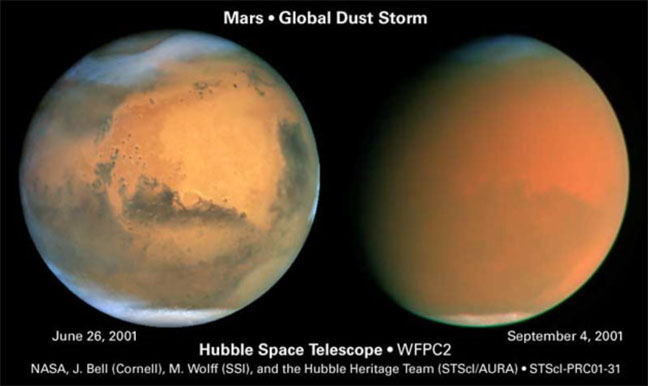
home •
about •
essential guide •
picture of the day •
thunderblogs •
news •
multimedia •
predictions •
products •
get involved •
contact
picture of the day archive subject index
In late June, 2001, the Hubble Telescope revealed the first stirrings of a dust storm in a small region of the Hellas
Basin on Mars. For several days the storm alternately grew, then retreated. Then it exploded and quickly boiled
out of the Hellas Basin, spreading both north and east. Within a few weeks it had covered the whole planet.
Oct 23, 2007
Martian Global Warming
Climate change on Mars may be happening more rapidly and dramatically than on Earth. As in the case of terrestrial "global warming," however, the electrical connection is still being ignored.
According to NASA scientists, the planet Mars has been steadily warming for at least the past several decades—and this warming is occurring at a pace that could destroy the planet’s southern ice cap in the foreseeable future.
The scientists say that the warming is similar to that of the Earth over roughly the same period. This possibility, in turn, could have major ramifications for the “global warming” issue. Since there is no evidence of living organisms contributing to temperature changes on Mars, current observations and measurements raise the distinct possibility that natural phenomena, largely overlooked in the “global warming” debate, could be contributing to rapid changes in planetary climates.But while NASA scientists acknowledge the mystery of warming on Mars, they continue to blur the relationship of cause and effect.
When a research team of scientists from NASA's Ames Research Center, together with the U.S. Geological Survey, compared images of Mars taken by the Viking missions in the 1970s to pictures taken a quarter century later by Mars Global Surveyor, they found something interesting. “The surface was noticeably darker in the new pictures,” said Lori Fenton, a planetary geologist at the Carl Sagan Center, who worked with Ames scientists on the project.
The scientists believe that changes in surface reflectivity — known as albedo — are caused by wind-driven dust storms that occasionally sweep the entire Martian surface. Plugging in a climate model developed at Ames, the research team said the changes in surface reflectivity could account for a 1 degree Fahrenheit rise in the surface temperature of the planet.
At this point, the critical questions are far more urgent than mere speculations. What is causing the winds? What is creating the darkened dust? What is excavating dust from the surface (both light and dark) and raising it in spectacular tornadic columns? What is selectively depositing darkened dust across the surface of Mars, often in exotic patterns that are inconceivable under electrically neutral conditions? What is the relationship of such activity to unexplained events in the Martian polar regions (e.g., mysterious “spiders,” “Dalmation spots,” “wind streaks,” and “Swiss cheese,” and much more)?
In a paper published in the journal Nature, Fenton and her team attribute the warming of Mars to strong winds caused by variations in radiation and temperature across the Martian surface. These winds, according to Fenton, stir up giant dust storms, trapping heat and raising the planet's temperature.
We have discussed the global Martian dust storms previously on these pages. NASA scientists have yet to address the most fundamental question. How does an atmosphere less than one percent as dense as Earth's remove dust from the soil and accelerate it into massive clouds circling the planet up to 40 miles or more above the surface?
The more we learn about these storms the more clearly they challenge the assumptions of both meteorologists and planetary scientists. In the great Martian dust storm of the summer of 2001, the entire planet was immersed, and the storm did not subside for several months. As the storm clouds began to surround Mars, temperatures rose a stunning 40 degrees C -- a case of "instantaneous global warming" that left planetary scientists scrambling for answers. Yet for decades we were told, that a cloud of this sort would cause cooling (as in astronomer Carl Sagan’s Doomsday event, the “nuclear winter”).
Today, new images of Mars continue to pour in, many in stunningly high resolution, Already dozens of earlier statements by NASA scientists, in answer to Martian mysteries, have been either thrown into doubt or categorically eliminated.
As we see it, the underlying questions and contradictions involve three interconnected threads that we intend to explore at length in coming weeks. 1) What is the relationship of “global warming” on planets to the behavior of the electric sun; 2) Can present activity on Mars provide new clues to this electrical connection? 3) Does the present activity on Mars offer analogies that could help us understand the higher energy events in the planet’s not-so-distant past?
___________________________________________________________________________Please visit our Forum
The Electric Sky and The Electric Universe available now!

|
|

|
EXECUTIVE EDITORS:
David Talbott, Wallace Thornhill
MANAGING EDITORS:
Steve Smith, Mel Acheson
CONTRIBUTING EDITORS: Michael Armstrong, Dwardu Cardona,
Ev Cochrane,
C.J. Ransom, Don Scott, Rens van der Sluijs, Ian Tresman
WEBMASTER: Brian Talbott
Copyright 2007: thunderbolts.info
![]()
home •
thunderblogs •
forum •
picture of the day •
resources •
team •
updates •
contact us

